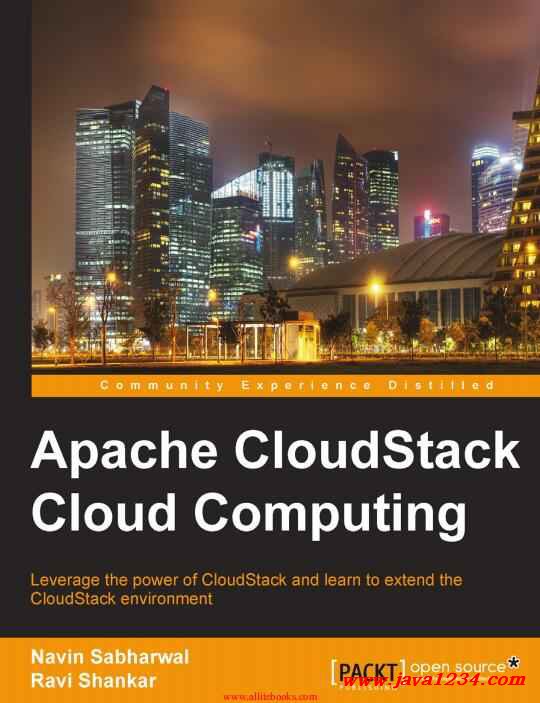| 失效链接处理 |
|
Apache CloudStack Cloud Computing PDF 下载
本站整理下载:
相关截图:

主要内容:
Use of switches in cloud
A switch is a LAN device that works at the data link layer (layer 2) of the OSI model
and provides multiport bridge. Switches store a table of MAC addresses and ports. Let
us see the various types of switches and their usage in the cloud environment:
• Layer 3 switches: A layer-3 switch is a special type of switch which operates
at layer 3—the Network layer of the OSI model. It is a high performance
device that is used for network routing. A layer-3 switch has a IP routing
table for lookups and it also forms a broadcast domain. Basically, a layer-3
switch is a switch which has a router's IP routing functionality built in.
A layer-3 switch is used for routing and is used for better performance
over routers. The layer-3 switches are used in large networks like corporate
networks instead of routers. The performance of the layer-3 switch is better
than that of a router because of some hardware-level differences. It supports
the same routing protocols as network routers do. The layer-3 switch is
used above the layer-2 switches and can be used to configure the routing
configuration and the communication between two different VLANs or
different subnets.
• Layer 4-7 switches: These switches use the packet information up to OSI
layer 7 and are also known as content switches, web-switches, or application
switches. These types of switches are typically used for load balancing among
a group of servers which can be performed on HTTP, HTTPS, VPN, or any
TCP/IP traffic using a specific port. These switches are used in the cloud for
allowing policy-based switching—to limit the different amount of traffic on
specific end-user switch ports. It can also be used for prioritizing the traffic of
specific applications. These switches also provide forwarding decision making
like NAT services and also manages the state of individual sessions from
beginning to end thus acting like firewalls. In addition, these switches are
used for balancing traffic across a cluster of servers as per the configuration
of the individual session information and status. Hence these types of
switches are used above layer-3 switches or above a cluster of servers in the
environment. They can be used to forward packets as per the configuration
such as transferring the packets to a server that is supposed to handle the
requests and this packet forwarding configuration is generally based on the
current server loads or sticky bits that binds the session to a particular server.
[ 14 ]
Chapter 1
• Layer-3 traffic isolation provides traffic isolation across layer-3 devices. It's
referred to as Virtual Routing and Forwarding (VRF). It virtualizes the
routing table in a layer-3 switch and has set of virtualized tables for routing.
Each table has a unique set of forwarding entries. Whenever traffic enters,
it is forwarded using the routing table associated with the same VRF. It
enables logical isolation of traffic as it crosses a common physical network
infrastructure. VRFs provide access control, path isolation, and shared
services. Security groups are also an example of layer-3 isolation capabilities
which restricts the traffic to the guests based on the rules defined. The rules
are defined based on the port, protocol, and source/destination of the traffic.
• Virtual switches: The virtual switches are software program that allows one
guest VM to communicate with another and is similar to the Ethernet switch
explained earlier. Virtual switches provide a bridge between the virtual NICs
of the guest VMs and the physical NIC of the host. Virtual switches have
port groups on one side which may or may not be connected to the different
subnets. There are various types of virtual switches used with various
virtualization technologies such as VMware Vswitch, Xen, or Open Vswitch.
VMware also provides a distributed virtual switch which spans multiple
hosts. The virtual switches consists of port groups at one end and an uplink
at the other. The port groups are connected to the virtual machines and
the uplink is mapped to the physical NIC of the host. The virtual switches
function as a virtual switch over the hypervisor layer on the host.
Management layer
The Management layer in a cloud computing space provides management
capabilities to manage the cloud setup.
It provides features and functions such as reporting, configuration for the
automation of tasks, configuration of parameters for the cloud setup, patching,
and monitoring of the cloud components.
Automation
The cloud is a highly automated environment and all tasks such as provisioning
the virtual machine, allocation of resources, networking, and security are done in
a self-service mode through automated systems.
The automation layer in cloud management software is typically exposed through
APIs. The APIs allow the creation of SDKs, scripts, and user interfaces.
[ 15
|




 苏公网安备 32061202001004号
苏公网安备 32061202001004号



